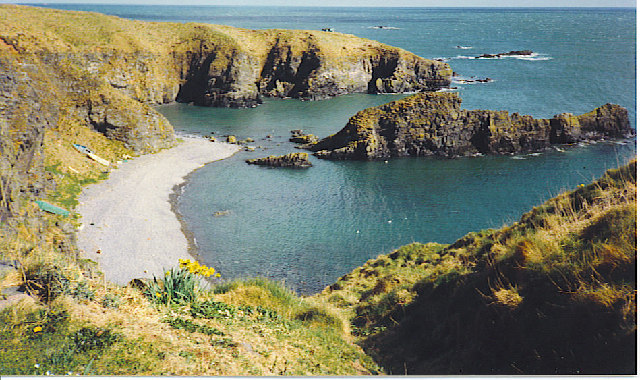Blind Man
Island in Aberdeenshire
Scotland
Blind Man

Blind Man is a small island located off the coast of Aberdeenshire, Scotland. With an area of approximately 0.5 square kilometers, it is one of the many islands that dot the Aberdeenshire coastline. Despite its small size, Blind Man Island holds great historical and cultural significance.
The island's name is believed to have originated from a local legend that tells the story of a blind man who was stranded on the island during a storm and miraculously found his way back to safety. This tale has been passed down through generations, contributing to the island's unique identity.
Blind Man Island is primarily known for its stunning natural beauty. The rugged coastline is adorned with picturesque cliffs and rocky outcrops, providing breathtaking views of the North Sea. The island is also home to a diverse range of flora and fauna, making it a haven for wildlife enthusiasts and nature lovers.
Although uninhabited today, Blind Man Island was once home to a small fishing community. Remnants of old cottages and fishing equipment can still be found, serving as a reminder of the island's past. Visitors can explore these historical sites and immerse themselves in the island's rich heritage.
Access to Blind Man Island is limited, as it can only be reached by boat. However, its remote location and tranquil atmosphere make it a popular destination for those seeking solitude and a break from the bustling city life.
In conclusion, Blind Man Island in Aberdeenshire offers a unique blend of history, natural beauty, and tranquility. Its rich folklore, stunning landscapes, and secluded location make it a hidden gem awaiting discovery.
If you have any feedback on the listing, please let us know in the comments section below.
Blind Man Images
Images are sourced within 2km of 57.36008/-1.9105088 or Grid Reference NK0529. Thanks to Geograph Open Source API. All images are credited.


Blind Man is located at Grid Ref: NK0529 (Lat: 57.36008, Lng: -1.9105088)
Unitary Authority: Aberdeenshire
Police Authority: North East
What 3 Words
///prefect.superhero.passports. Near Port Erroll, Aberdeenshire
Nearby Locations
Related Wikis
Old Slains Castle
Slains Castle (otherwise known as Old Slains Castle) is a ruined castle near Collieston in Aberdeenshire, Scotland. It is not to be confused with New Slains...
Collieston
Collieston is a small former fishing village on the North Sea coast in Aberdeenshire, Scotland. The village lies just north of the Sands of Forvie Special...
Meikle Loch
Meikle Loch is an inland loch some miles north of Collieston, Aberdeenshire, Scotland. It is designated as part of the Ythan Estuary complex, along with...
Cotehill Loch
Cotehill Loch is a freshwater loch located in Scotland in the Aberdeenshire area, approximately one mile (1.5 km) northwest of the coastal town of Collieston...
Ythan Estuary
The Ythan Estuary (Scottish Gaelic: Inbhir Eithein) is the tidal component of the Ythan River, emptying into the North Sea 19 kilometres (12 mi) north...
Whinnyfold
Whinnyfold or Whinneyfold is a small coastal village at the southern end of the Bay of Cruden in Aberdeenshire, Scotland. Whinnyfold (locally pronounced...
Hackley Head
Hackley Head (otherwise Forvie Ness) is a headland in Aberdeenshire, northeast Scotland. Hackley Head is located to the south of Hackley Bay and to the...
Forvie
Forvie was a village in what is now the Forvie National Nature Reserve, located at the modern location of Rockend some fourteen miles north of Aberdeen...
Nearby Amenities
Located within 500m of 57.36008,-1.9105088Have you been to Blind Man?
Leave your review of Blind Man below (or comments, questions and feedback).




















